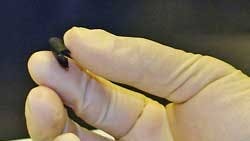Researchers at Rensselaer Polytechnic Institute have developed an energy storage material that simultaneously performs the functions of both a rechargeable battery and a supercapacitor, yet has the physical properties of a sheet of paper (see the Figure). This nanocomposite paper material is non-toxic, highly biocompatible with human tissue, and robust—both physically and thermally. It therefore holds great potential to advance capabilities in portable power design for applications ranging from bioinstrumentation to consumer electronics, and even large power systems served by conventional batteries.
The creation of the nanocomposite paper draws from a diverse pool of disciplines, requiring expertise in materials science, energy storage, and chemistry. Robert Linhardt, the Ann and John H. Broadbent Senior Constellation Professor of Biocatalysis and Metabolic Engineering at Rensselaer, is one of the researchers who developed the technology. Linhardt states that the paper-like qualities of the material make it especially attractive for energy storage in medically implanted devices (for example, a pacemaker, insulin pump, or the implantable radio chip discussed here).
According to Linhardt, this is mainly because the material may enable energy storage devices that can be placed directly beneath the skin, rather than deep inside the body, which is the usual practice. Such thin devices would have the dual advantages of being less invasive and easier to recharge. Of course, other properties of the material that favor such applications are its high levels of biocompatibility and mechanical flexibility.
For example, the material can be rolled, twisted, folded, or cut into any number of shapes with no loss of mechanical integrity or efficiency. It can also be fabricated in a continuous sheet to any desired area while maintaining its uniform paper-thin profile. Paper batteries made from this material can also be stacked, like a ream of printer paper, to boost the total power output.
The material’s general semblance to paper is due to the fact that the composition of the material is more than 90% cellulose. This is the same type of organic plant material used in newsprint, lunch-bags, loose-leaf paper, and nearly every other type of paper. Not surprisingly, the technology is manufactured using a technique that resembles a printing process.
To manufacture the nanocomposite material, Rensselaer researchers infuse this paper with aligned carbon nanotubes, which gives the material its black color. The nanotubes act as electrodes and allow the paper to conduct electricity.
The researchers use ionic liquid, essentially a liquid salt, as an electrolyte. The electrodes and the electrolyte are then combined to form the nanocomposite paper battery material. This material then acts as a unique energy storage device in that it can function as both a high-energy rechargable battery and a high-power supercapacitor, which are generally separate components in most electrical systems.
Linhardt states that fellow researchers Victor Pushparaj, Manikoth Shaijumon, Saravanababu Murugesan, Ashavani Kumar, Omkaram Nalamasu and Pulickel Ajayan, have devised a three-terminal hybrid supercapacitor/battery device using this technology. Their hybrid device can be used in place of a conventional four-terminal device.
It is important to note that the ionic liquid used for the electrolyte contains no water, and will not freeze or evaporate; these nanocomposite paper batteries can therefore operate from +300°F to -100°F. Another key feature of the technology—which also further contributes to its high level of biocompatibility—is the capability to use human blood or sweat as substitute electrolytes to power the battery.
Linhardt states that the nanocomposite paper batteries also have a typical open-circuit voltage of 2.5 V, and that power density for the batteries is still being optimized. However, the first supercapacitors produced with the technology already have a power storage density comparable to equivalent commercial devices.
The Rensselaer research team has already filed a patent protecting the invention. They are now working on ways to boost the efficiency of the batteries and supercapacitors, and investigating different manufacturing techniques.
Linhardt states that for other applications, such as those for wearable electronics, it might be more desirable for the batteries to more closely resemble woven fabric rather than printable paper. For such applications, the researchers might apply fiber-forming technologies and actually weave, rather than print, a battery.
However, the essence of this technology in its current form is effectively summarized by Linhardt as follows: “It’s essentially a regular piece of paper, but it’s made in a very intelligent way.”
Details of the project are outlined in the paper co-authored by Linhardt, “Flexible Energy Storage Devices Based on Nanocomposite Paper,” published Aug. 13 in the Proceedings of the National Academy of Sciences.
